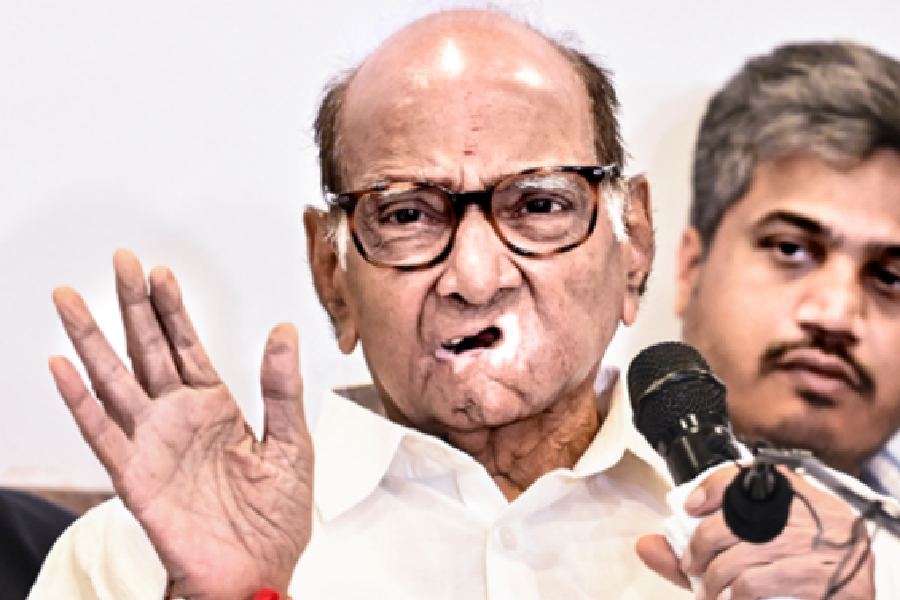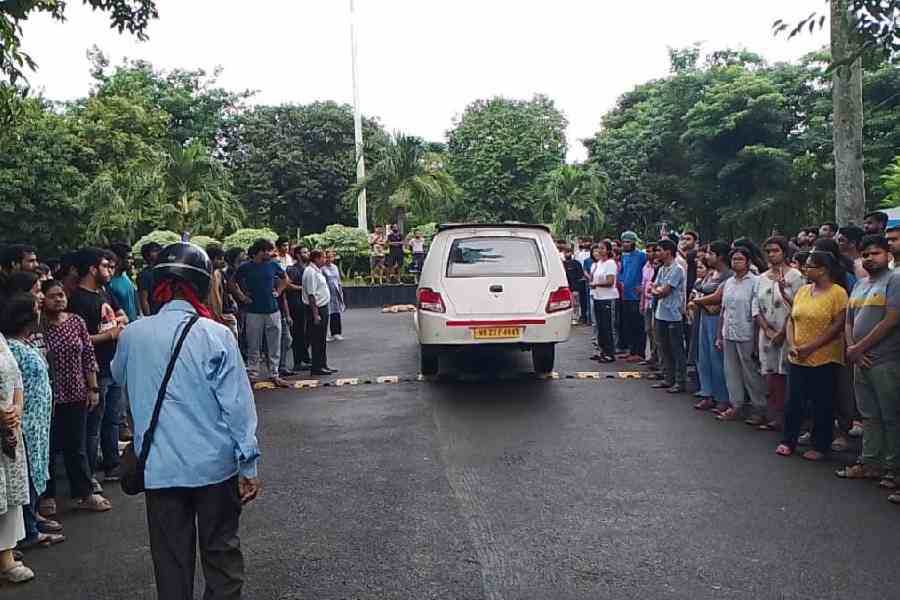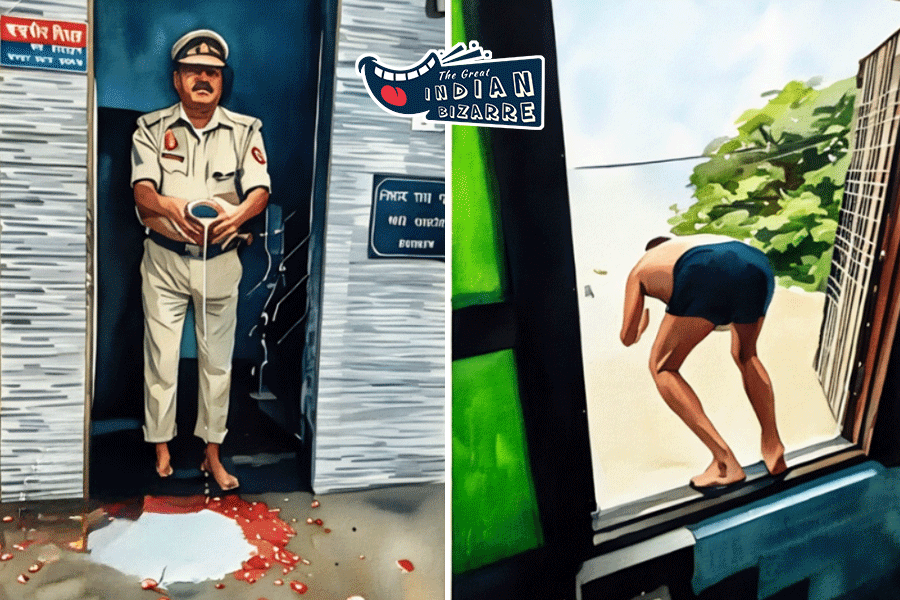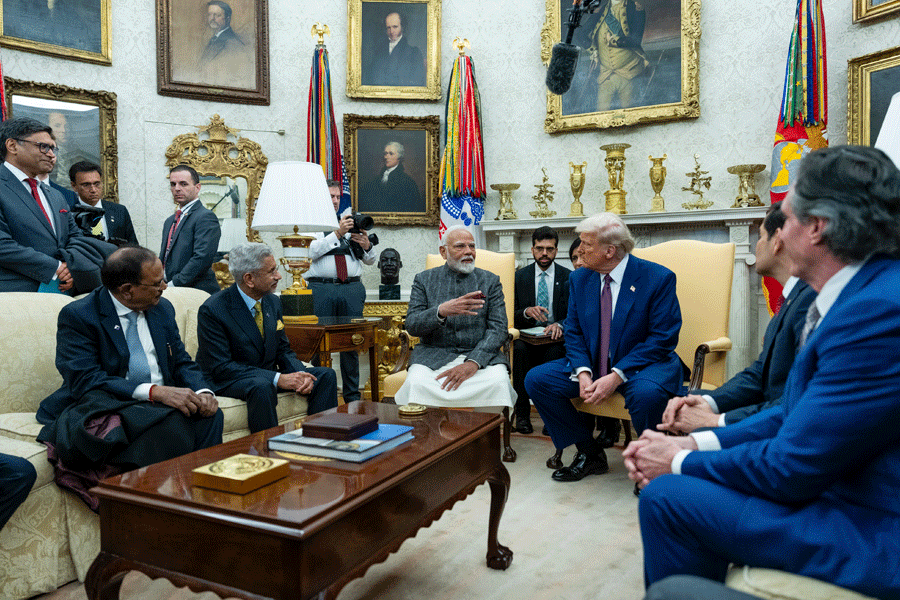|
|
| Best of both worlds |
I went to eat at a relatively new restaurant that’s opened in South Calcutta. The decor was pleasingly minimalist, but for a fondness for usual-suspect Rock ’n Roll cards hanging from the windows. The table details were also nice except for the unfortunate ‘satin’ napkins that felt like they wouldn’t absorb any liquid at all, forget about a spill of thick gravy. But. The food was great and came at very reasonable prices. It wasn’t “fusion”, as the chef’s note stresses, but an attempt at new developments on classic Bengali cooking. The starter of what can only be described as small cutlets of chhana and posto, cottage cheese and poppy seed, was okkkay, but after that the grub really took off. There were skewers of pineapple and mushroom with an intensely green coriander-chilli-garlic sauce, there was a “melange of vegetables” in spiced mango cream, a gravied aam diye chorchori of sorts that was satisfying yet surprising, its speedboat, powered by spice and sweetness, skimming close enough to Thai waters to invite irate machine-gun fire from their culinary border guards yet managing to stay cheekily just within Bengal territory. The best dish for me was a “steamed breast of chicken with radhuni enriched curry sauce” where the roasted methi seeds and radhuni were fully amped up and distorting fully beautifully, like say Jimmy Page and Robert Plant at their Led Zep peak. It was a pleasure to taste and see a genuinely new language emerging, pushing its wings out from the eggshell of an older one. For a change. This meal satisfied a hunger for new combinations, the desire for new experience that crosses bodily senses, mediums and genres, intellect, instinct and intestines.
What we now call ‘fusion’ has always been with us, of course. The incorporation of the chilli, potato and tomato through the good offices of the Portuguese into pan-Indian cuisine is one great example. The ‘Anglo’ mixtures thrown up by the cross-frying of Indian and English cultures is too well known to recount here. By the 1970s, we in urban India had two more fusions well on their way — the food now found almost on every street corner that we know as ‘Indian Chinese’ and the various purloinings twisted from the American fast food menu, the ‘Veg Burger’ and the ‘Mutton Hamburger’, the ‘hot dog’, the ‘pijhaa’ in its early desi avatars before the landing of the so-called ‘genuine’ American pizzas (as in discs industrially produced by giant corporations specializing in edible plastics, the profits going to anti-abortion campaigns in Utah and such) (therefore bearing no relation to the great culinary invention of Naples nor its early 20th century evolutions in New York and Chicago).
These were, if you like, stages of unselfconscious naturalization. In music terms, think of the Hindi film songs of the 1940s and 1950s which happily used the tango and the waltz, the Russian elements in Raj Kapoor soundtracks, the use of the accordion and the advent of massed strings playing raga-based melodies. In art terms, perhaps this is comparable to the Kalighat pat painters and Raja Ravi Varma differently siphoning off Western techniques, including shading and perspective vernaculars.
In Hindi films, a more conscious lifting or ‘permanent borrowing’ begins in the early 1960s. Suddenly, in the shape of Shammi Kapoor, you have a lip-sync Elvis but with a comprehensive tadka of local spices. Suddenly, or perhaps not so suddenly, the horn arrangements and guitar funk of James Brown have Indian youth dancing, even as they influence the complex Free Jazz of Ornette Coleman at the other extreme end of the scale. The wailing of a lone (usually) alto sax becomes a signature under every Helen dance number and millions of South Asians such as myself grow up thinking of these as the home sounds of our childhoods and early adolescence. In food, this more conscious indigenization begins only in the late 1980s and early 1990s. Think paneer pizza and cheese dosa, and then chow mein dosa and chilli chicken pizza, all invented and consumed under the overarching rule of the taste-thugs of the Famiglia di Maggi Noodlianis.
Again, this self-conscious mixing of foreign ingredients is connected to but essentially different from wholesale plagia-transliteration. To go back to music, Tagore starts it with his re-frying of Auld Lang Syne. This is followed by a xerox of Mozart’s 40th Symphony as Itna na mujhse tu pyar badha, ki main ik badal awara. The next grand heist is from Donovan’s If it’s Tuesday, this must be Belgium, a melody hugely improved when it becomes Chura liya hai tumne jo dil ko (which in turn is re-modelled into another hit 20 years later). All of these pale in comparison with the arrival of the hardest listening man in show business, Grandmaster Bhappi, who I always think of as a man with very wide arms scooping up hundreds of cassettes of disco and stuffing them into his mouth. As these things do not work in synchronization, in art terms we reach this stage only at the turn of the millennium.
Between Raja Ravi Varma and the explosion of ‘Indian Contemporary’ on the world stage, there has been this quite serious engagement with European and American modernism, Picasso, Cubism, Surrealism etc, yielding mixed but wonderful results. If Hindi music has had Bhappi-da, modern Indian art has had Maqbool Fida. But there is also, from the late 1970s, a whole, diversely constituted generation of painters from Subramayan, Khakhar, Sheikh, Pyne, Chowdhury, Malani, Nilima Sheikh, Khanna, Sundaram, Dodiya (who’s slightly younger) and others who have de-Husainified us and given us a body of work which is both Indian and timeless. This, however, doesn’t cut it with the next batch of ‘practitioners’. Too many of the ‘In-Con’ bunch count on two things, the first is a mixture of Western critical amnesia and Indian critical ignorance, the second is that Western galleries and critics subconsciously do believe that crass imitation is the best, most delectable form of flattery. So we have re-warmed and surface-Indianized Claes Oldenburg, Cindy Sherman, Joseph Beuys and Marcel Duchamp, just to name a few of the victims. Seeing a lot of the In-Con work, especially in an international context, is truly baffling. For an Indian, it’s a little shaming too, as though your cousin brother’s been caught shoplifting at Harrod’s.
The same feeling doesn’t arise when you listen to yet another spawn of the classic Bhappi tradition of plagia-transliteration, possibly because these Bombay copy-posers are not being touted as Great Indian Artists in the Big Bad Bairey. What happens when you hear a Bombay photocopy of an originally terrible heavy metal or country and western song is a feeling of irritation and disappointment more than anything else. Of course, when a composer does a straight lift of some foreign pop song, he’s counting on amnesia or ignorance from his audience as much as any avant-fraud ‘In-Con’ practitioner, but at some level you let it pass because it’s about money, not about art, and when you do get an original classic like Dil to bachcha hai ji, Masakali or O re piya, you feel it’s a bonus, you’ve found a diamond in the industrial garbage dump.
Listening to one of these new beauties you are reminded that there is a third stage of fusion now in progress, all over the world. The sensibility of this mixage is informed, definitely cosmopolitan, but the idea and the confidence to execute the experiment comes from wanting to push within the boundaries of one’s own tradition. One splendid example of this is what’s called the New British Cooking where chefs such as Heston Blumenthal have used extreme chemistry and even more extreme imagination to re-work traditional local ingredients. Blumenthal is very much a product of what can be called the Modern European school, which in turn owes most of its principles to French Haute Cuisine and Nouvelle Cuisine, but it is by simultaneously going deep into old ingredients and new techniques that he has become one of the most highly regarded and highly copied chefs in the world.
One of the best things in the Nouvelle-Bongeau Resto we visited was the seemingly simple side dish of “wilted greens” or shaak to locals of all classes, made from kolmi shaak, green chili, onions, garlic, and crumbled masur daal boris. The way this perfectly cooked shaak exploded and cleansed your palate between mouthfuls of the other dishes was extraordinary. It owed nothing to any Western dish, any superficial idea of fusion or to any plagiarized recipe. It got me thinking that there was a lesson here for many of our artists and music composers.












